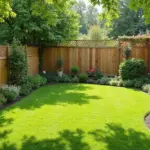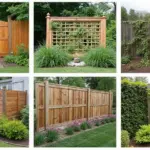There’s nothing quite like the gentle sway of a porch swing to transform your outdoor space into a peaceful retreat. Whether you’re sipping morning coffee or watching the sunset we’ve all dreamed of that perfect spot where relaxation meets style.
Hanging a porch swing isn’t just about installation—it’s about creating the ideal sanctuary that reflects your personal taste while ensuring safety and durability. From traditional ceiling-mounted options to creative alternatives for porches without overhead support we’ll explore innovative answers that work for every home.
The right hanging method can make or break your porch swing experience. Poor installation leads to squeaky hinges wobbly seats and potential safety hazards. But with proper planning and the right techniques you’ll create a stunning focal point that’ll become your family’s favorite gathering spot for years to come.
Choose the Perfect Location for Your Porch Swing
Selecting the right spot for your porch swing installation determines both comfort and safety for years to come. We’ll walk you through the key factors that make certain locations ideal for hanging your porch swing.
Assess Your Porch Structure and Weight Capacity
Structural integrity forms the foundation of every successful porch swing installation. We recommend examining ceiling joists, beams, and support posts to ensure they can handle the ever-changing weight load. Most porch swings require structural support capable of bearing 400-500 pounds, accounting for multiple occupants and swinging motion.
Ceiling height plays a crucial role in swing placement and safety. We suggest measuring at least 24-30 inches of clearance from the swing seat to any walls or railings. Standard porch swings need approximately 8-10 feet of ceiling height for comfortable swinging motion without interference.
Professional assessment becomes necessary for older porch structures. We advise consulting a structural engineer if your porch shows signs of sagging, cracking, or water damage. These issues can compromise the weight bearing capacity and create safety hazards during installation.
Consider Traffic Flow and Privacy Needs
Traffic patterns around your porch determine swing placement success. We observe that swings positioned near main walkways often create bottlenecks and reduce relaxation potential. Corner locations or areas away from primary foot traffic provide better seating experiences.
Privacy considerations enhance your porch swing sanctuary. We recommend choosing spots that offer natural screening from neighbors or busy streets through existing landscaping, architectural features, or porch railings. Strategic placement near garden areas or facing peaceful views maximizes tranquility.
Multiple seating options require careful spacing analysis. We suggest maintaining at least 3-4 feet between porch swings and other furniture pieces like chairs, tables, or planters. This spacing prevents collisions during swing motion and maintains comfortable conversation distances.
Evaluate Sunlight and Weather Exposure
Morning sun exposure creates ideal porch swing conditions. We find that east facing locations provide gentle morning light while offering afternoon shade protection. This orientation extends comfortable usage hours throughout the day and prevents fabric fading from harsh afternoon sun.
Wind patterns significantly impact swing comfort and durability. We recommend observing prevailing wind directions during different seasons to avoid locations with excessive exposure. Protected areas near walls or under deeper roof overhangs reduce weather related wear and improve user comfort.
Seasonal weather changes affect swing location preferences. We suggest considering factors like snow load, rain exposure, and temperature variations when selecting permanent installation spots. Covered areas with adequate drainage protect both swing materials and hanging hardware from moisture damage.
Select the Right Hardware for Safe Installation
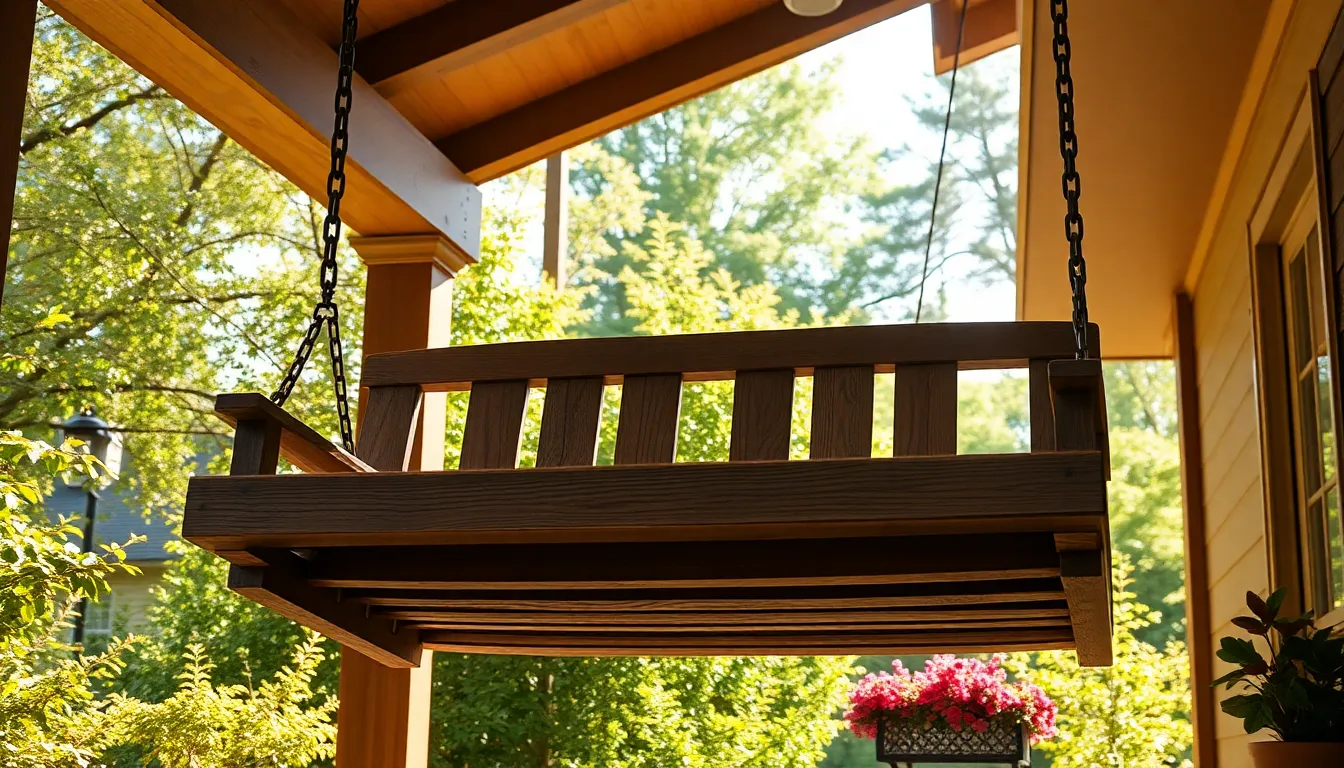
Choosing the right hardware makes the difference between a safe, enjoyable porch swing and a potential safety hazard. We’ll guide you through the essential components that ensure your swing stays securely mounted for years to come.
Heavy-Duty Ceiling Hooks and Eye Bolts
Heavy-duty ceiling hooks and eye bolts serve as the foundation of any secure porch swing installation. These robust mounting points must be installed directly into load-bearing joists or additional structural supports to prevent catastrophic failure.
Installation requires at least four mounting points – two on each side of the swing – to distribute weight evenly across the structure. Eye bolts rated for your expected load capacity provide the most reliable connection point for swing chains or ropes.
Pilot holes are essential before installing any ceiling hardware. Drilling these guide holes prevents wood splitting and ensures your eye bolts thread properly into the joists. Most installations benefit from eye bolts that penetrate at least 3 inches into solid wood for maximum holding power.
Chain vs Rope: Pros and Cons
| Feature | Chain | Rope |
|---|---|---|
| Durability | Excellent – weather resistant and strong | Good – requires regular maintenance |
| Noise Level | Higher – can be noisy during swing motion | Lower – provides quieter operation |
| Maintenance | Minimal – may need rust prevention | Frequent – susceptible to weather damage |
| Flexibility | Limited – less prone to stretching | High – provides more give and flexibility |
| Aesthetic Appeal | Industrial look | Natural, traditional appearance |
Chains offer superior longevity and require less maintenance than rope alternatives. Stainless steel or coated chains resist rust and corrosion while providing consistent support over time. The trade-off comes in noise levels, as metal chains create more sound during swing motion.
Rope provides aesthetic appeal and quieter operation but demands more attention. Weather exposure causes rope to stretch and deteriorate, requiring periodic replacement to maintain safety standards. Many homeowners choose rope for its traditional appearance even though the increased maintenance requirements.
Spring Systems for Added Comfort
Spring systems transform your porch swing experience by absorbing shocks and smoothing the swinging motion. These components install between your ceiling hooks and the swing’s hanging mechanism to reduce jarring movements.
Shock absorption protects both hardware and occupants from sudden jolts during swing use. Springs distribute force more evenly across mounting points, reducing stress on eye bolts and ceiling joists. This protection becomes especially valuable for heavier swings or households with frequent swing use.
Installation involves connecting springs between your ceiling hooks and swing chains using appropriate hardware. Quick links or similar fasteners provide secure connections while allowing for easy maintenance access. Most spring systems add 6-8 inches to your total hanging length, so factor this into your ceiling height calculations.
Measure and Mark Your Hanging Points Accurately
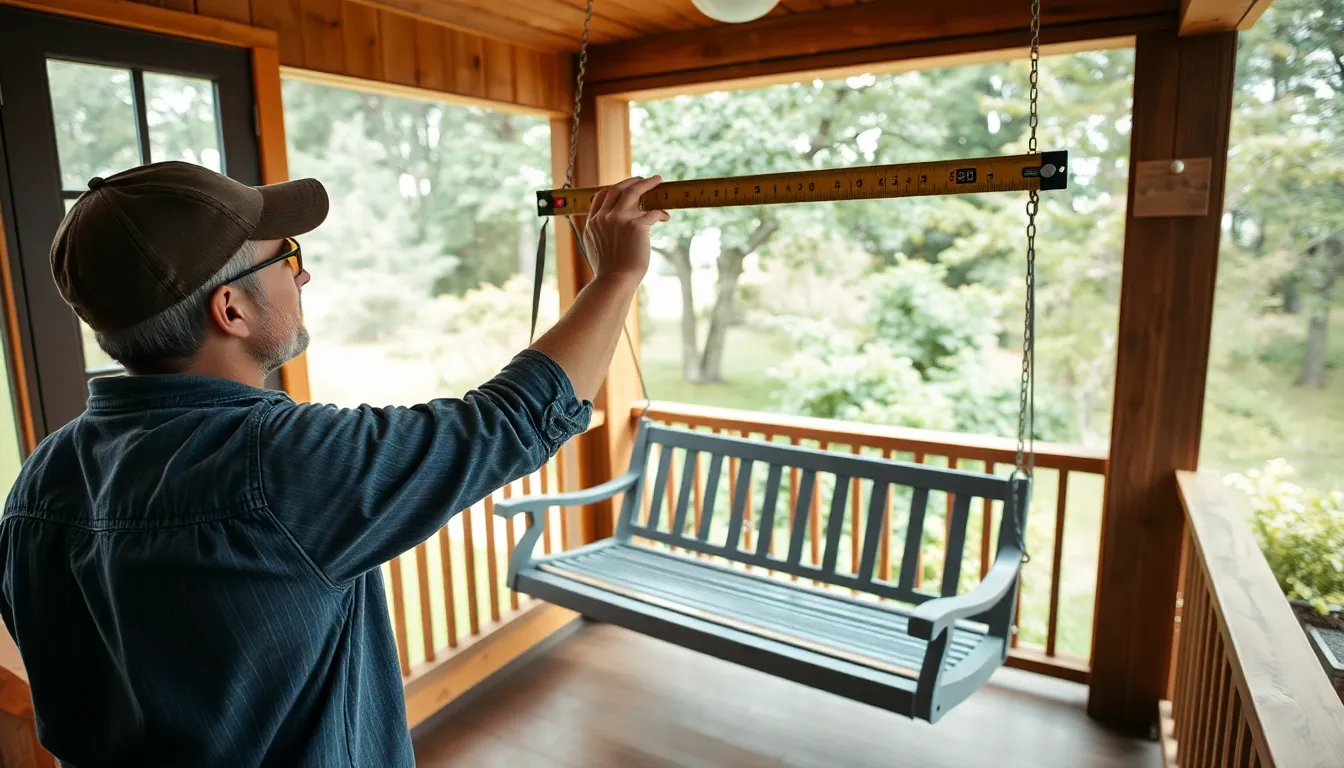
Precise measurements form the foundation of any successful porch swing installation. We’ll guide you through the critical steps that ensure your swing hangs safely and comfortably.
Calculate Proper Swing Height from Floor
Setting the correct height creates the perfect balance between comfort and safety for all users. We recommend positioning the bottom of your swing seat between 17 to 19 inches above the ground level. This height range allows easy access for most adults while providing adequate clearance for natural swinging motion.
Measuring from the floor to your planned ceiling attachment points helps determine the total chain or rope length you’ll need. Account for the swing’s seat thickness and any cushions you plan to add when calculating the final measurements. Consider that children and elderly family members may need slightly different heights for optimal comfort.
Test different heights by temporarily positioning the swing at various levels before making permanent installations. We find that 18 inches works well for most households as a comfortable middle ground.
Determine Optimal Chain Length and Spacing
Chain length directly affects your swing’s performance and the overall user experience. Begin by measuring the distance from your ceiling attachment points to the desired seat height. Subtract the swing’s mounting hardware height from this measurement to determine your required chain length.
Both chains must maintain identical lengths to prevent tilting and ensure level seating. We recommend using adjustable chain links or quick-connect hardware that allows for fine-tuning after installation. Mark each chain at the same measured point to maintain consistency during attachment.
Spacing between your hanging points should match your swing’s frame width exactly. Most standard porch swings require hanging points spaced 4 to 6 feet apart, depending on the exact model dimensions. Measure your swing’s mounting brackets or eye bolts to determine the precise spacing needed.
Use a Level for Perfectly Balanced Installation
Achieving perfect balance prevents uneven wear and ensures comfortable seating for years to come. Place a carpenter’s level across the swing seat immediately after hanging to check for any tilting or uneven positioning. Even small imbalances can cause important comfort issues over time.
Adjust chain lengths incrementally if you notice any deviation from level positioning. We suggest making small adjustments of one or two chain links at a time rather than large corrections. This approach prevents overcorrection and helps you find the perfect balance point.
Testing involves more than just visual inspection with a level tool. Sit gently on different areas of the swing to ensure it remains stable and doesn’t tip toward either side. Make final adjustments based on how the swing responds to actual weight distribution during use.
Install Ceiling Mounts in Different Ceiling Types
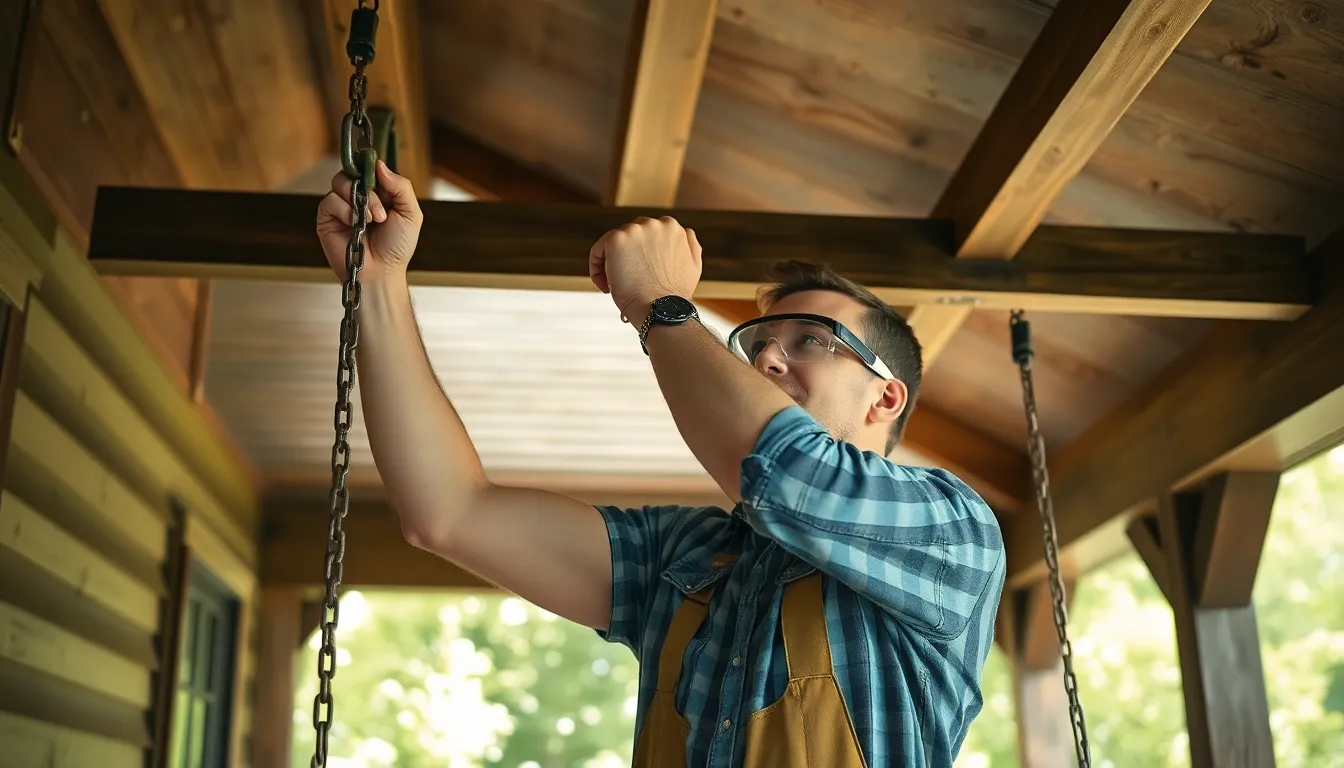
Successful porch swing installation depends entirely on matching your mounting method to your exact ceiling material. We’ll guide you through the proven techniques for securing ceiling mounts in wood, concrete, masonry, and metal structures.
Mounting in Wood Ceiling Joists
Locating sturdy wooden ceiling joists directly above your porch provides the most reliable foundation for swing installation. We recommend using heavy-duty eye bolts or lag screws that drill straight into these structural supports for maximum holding power.
Drilling pilot holes into the joists prevents wood splitting and ensures clean installation. This step becomes especially critical when working with older wood that may be more brittle or prone to cracking under pressure.
Installing additional blocking or furring strips may be necessary if your porch ceiling features vinyl covering or thin paneling. These materials don’t provide adequate backing for mounting hardware on their own.
Attaching chains or ropes to the eye bolts requires careful measurement to ensure the swing hangs evenly at 17-19 inches above the floor. We always verify that our mounting hardware allows the swing to pivot smoothly parallel to the house facade.
Confirming that joists and mounting points can support at least 500 pounds creates the essential safety margin for ever-changing loads during use.
Installing in Concrete or Masonry Ceilings
Using appropriate masonry anchors like expansion bolts or sleeve anchors designed specifically for concrete or brick ensures secure attachment in these challenging materials. We drill holes using a hammer drill with masonry bits sized precisely to match our anchor specifications.
Inserting anchors securely before threading in heavy-duty eye bolts prevents loosening over time and maintains structural integrity. This method requires patience as concrete and masonry work differently than wood installations.
Verifying anchor capacity to handle ever-changing loads of the swing becomes crucial since masonry installations face different stress patterns than wood mounts. We always use professional-grade hardware designed specifically for masonry applications to guarantee safety.
Threading chains or ropes through hooks attached to the eye bolts completes the installation while maintaining the proper swing height and movement range.
Working with Metal Porch Ceilings
Metal beam or ceiling structures require specialized hardware such as beam clamps or toggle bolts rated for heavy loads and metal applications. We locate structural metal beams or trusses rather than decorative metal elements to ensure adequate support.
Welding or drilling into metal may require professional tools and expertise depending on the thickness and type of metal structure. Some installations benefit from bolt-on mounting brackets specifically designed for metal frameworks.
Securing mounts to structural members capable of supporting the swing plus occupants eliminates safety concerns common with inadequate mounting attempts. We never compromise on this requirement regardless of installation complexity.
Hanging chains from metal mounts and attaching them to the swing seat completes the process while ensuring weather-resistant connections that withstand outdoor conditions year-round.
Create Alternative Hanging Solutions for Unique Spaces

Not every porch offers the perfect setup for traditional hanging methods. Fortunately, we can explore creative alternatives that work beautifully in unique outdoor spaces.
Freestanding A-Frame Swing Stands
Freestanding A-frame swing stands solve the problem when you can’t hang a swing from your porch or ceiling. These versatile structures allow us to place porch swings almost anywhere in our yard, garden, or patio without needing permanent installation.
Available materials and styles include:
- Cedar stands for natural weather resistance
- Vinyl options for low maintenance
- Classic Amish-crafted models known for superior sturdiness
- Modern decorative designs that complement various outdoor aesthetics
Sizes accommodate both standard bench swings and larger swing beds, making them perfect for different outdoor settings. Popular options like Amish Casual Heavy Duty A-Frame stands and Luxcraft Vinyl A-Frame stands offer reliable performance with included hangers for easy setup.
DIY enthusiasts can build custom frames using:
- 2×6 lumber for the main structure
- Simpson Strong-Tie outdoor accents for decorative stability
- Standard hardware that creates sturdy frames without digging holes or pouring concrete
Tree Branch Installation Methods
Hanging porch swings from sturdy, horizontal tree branches creates a classic outdoor experience when permanent porch structures aren’t available. We must carefully evaluate the branch’s ability to support the swing’s weight plus occupants before installation.
Essential safety considerations include:
- Selecting branches at least 8 inches in diameter
- Ensuring the branch shows no signs of disease or damage
- Using heavy-duty eye bolts specifically designed for outdoor use
- Installing galvanized chains that resist rust and corrosion
Proper hardware selection involves:
- Eye bolts rated for at least 500 pounds
- Swing hangers that distribute weight evenly
- Protective sleeves to prevent rope or chain damage
Tree branch swings provide natural aesthetics while creating comfortable seating in shaded backyard spaces. Professional arborists recommend annual inspections to ensure continued branch integrity and safety.
Pergola and Gazebo Mounting Options
Pergolas and gazebos offer excellent structural beams where we can securely hang swings with proper mounting techniques. These structures combine functionality with attractive outdoor design elements that enhance our living spaces.
Mounting options include:
- Vinyl and poly pergola-style swing stands that integrate swinging function with pergola frames
- Wooden pergolas with reinforced crossbeams for direct swing attachment
- Custom mounting kits designed specifically for pergola beam installation
Installation benefits include:
- Even weight distribution across multiple support points
- Integrated shade from pergola roofing
- Elegant outdoor seating that complements existing structures
- Protection from direct sunlight and light precipitation
Customized mounting brackets enable safe installation without damaging pergola structures. We recommend using stainless steel hardware to prevent corrosion and ensure long-lasting performance in outdoor environments.
- Standard pergolas support 200-400 pounds per beam
- Reinforced structures handle 500+ pounds safely
- Multiple mounting points distribute stress effectively
Add Safety Features and Weight Distribution
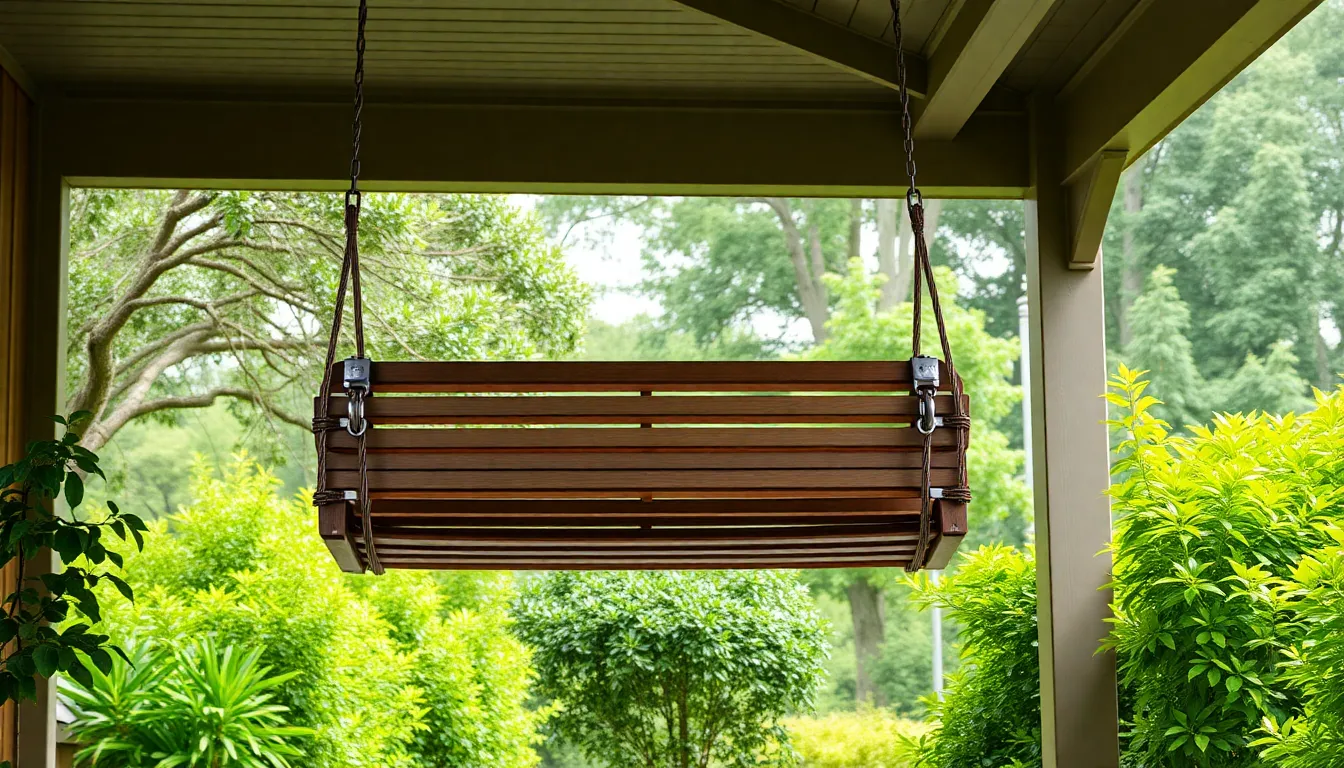
We’ll enhance your porch swing’s safety and longevity by implementing critical weight distribution techniques and backup systems. Proper weight distribution starts with spacing your hangers 2 to 4 inches wider than the swing’s length to prevent stress concentration at connection points.
Install Safety Cables as Backup Support
Safety cables serve as essential fail-safes that protect against primary suspension system failure. We recommend installing secondary cables alongside your main chains or ropes to create redundant support systems. These backup cables should run parallel to your primary hanging hardware and connect to separate anchor points when possible.
Aircraft cable or galvanized steel cable rated for at least 1/8 inch diameter provides excellent backup support. Position these cables to engage only if the primary system fails, allowing normal swing movement while maintaining emergency protection. We suggest attaching the safety cables with proper cable clamps and thimbles to prevent fraying and ensure maximum strength retention.
Use Swivel Hardware to Prevent Chain Twisting
Swivel hooks eliminate chain twisting that causes stress buildup and uncomfortable swinging motion. We install swivel hardware at both the ceiling attachment points and where chains connect to the swing frame. This dual swivel system allows natural rotation during use while preventing dangerous chain kinking.
Heavy duty swivels rated for 400 pounds or more ensure smooth operation under load. Ball bearing swivels provide the smoothest rotation and longest service life compared to simple pin swivels. We position swivels to allow 360 degree rotation while maintaining proper chain alignment throughout the swing’s arc.
Quality swivel hardware reduces maintenance requirements by preventing chain wear from twisting forces. This hardware investment extends your swing’s lifespan while maintaining comfortable, natural swinging motion for years of enjoyment.
Check and Reinforce Connection Points
Regular inspection of all hardware connections maintains safety and prevents catastrophic failure. We examine eye bolts, chains, links, and swivel connectors monthly for signs of wear, rust, or loosening. Tightening hardware and replacing worn components before they fail ensures continued safe operation.
Connection points require reinforcement when supporting heavy loads or showing stress signs. We use pilot holes when installing new hardware to prevent wood splitting and ensure secure attachment to ceiling joists. Washers distribute load across larger surface areas, reducing stress concentration at bolt holes.
Visual inspection should include checking for cracks in wood around mounting points and ensuring all hardware remains tight. We recommend professional inspection annually for swings receiving heavy use or exposure to harsh weather conditions. This proactive approach prevents accidents while maintaining your swing’s structural integrity.
Enhance Your Swing with Decorative Elements
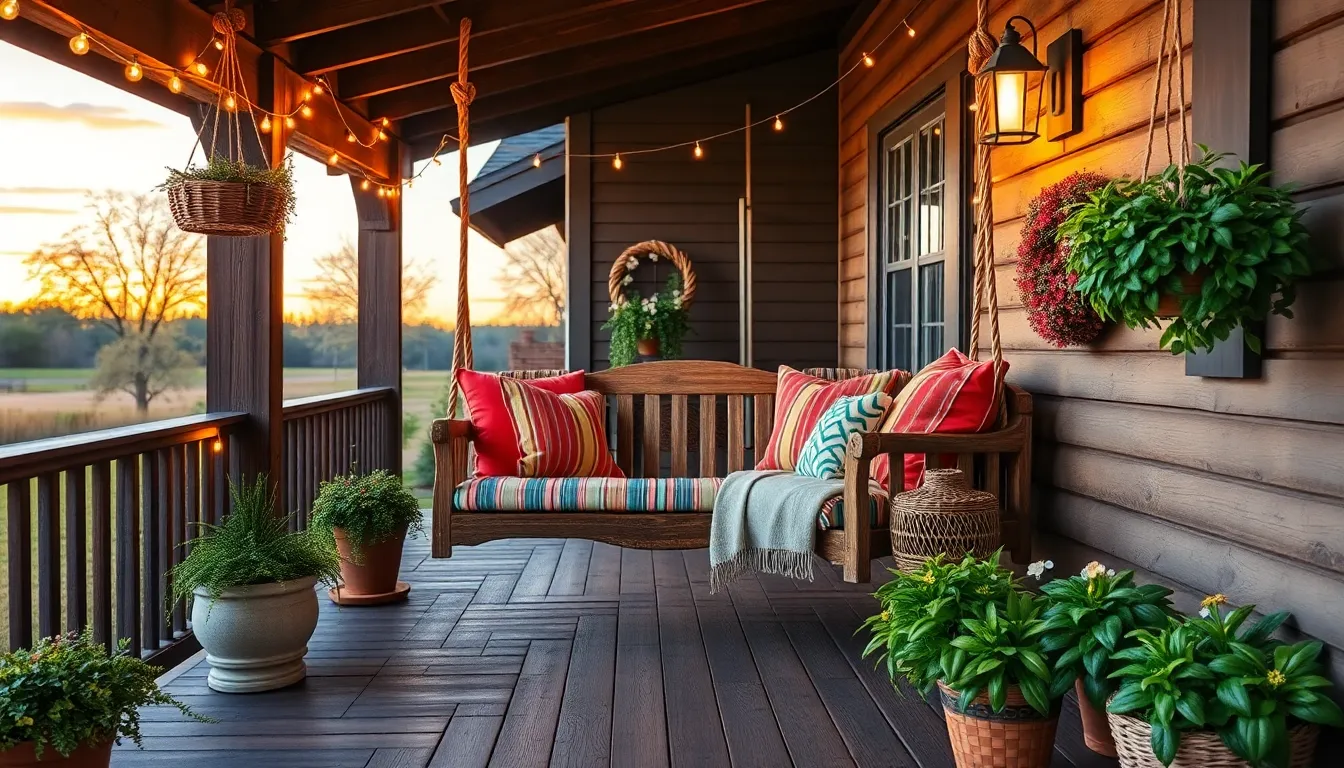
Once you’ve mastered the technical aspects of swing installation, we can transform your porch swing into a stunning focal point that reflects your personal style. Decorative enhancements not only boost visual appeal but also improve comfort and functionality for years of enjoyment.
Rope Covers and Chain Guards
Protecting your swing’s hanging hardware with decorative covers serves dual purposes: safety enhancement and aesthetic improvement. We recommend installing rope covers or chain guards to prevent wear on suspension components while adding visual interest to your swing setup.
Chain guards eliminate the harsh metallic appearance of raw chains and reduce noise during swinging motion. Rope covers provide a softer, more nautical look that complements coastal or rustic porch designs perfectly.
Professional installation consultation ensures these protective elements integrate seamlessly with your swing’s support system. We suggest choosing covers that match your porch’s overall design theme, whether that’s traditional, farmhouse, or contemporary styling.
Cushions and Pillow Arrangements
Cushions transform basic porch swings into luxurious seating areas that invite extended relaxation sessions. We recommend selecting all-weather fabrics that withstand outdoor conditions while maintaining their softness and vibrant colors throughout the seasons.
Neutral tones like grey, brown, or white offer versatile styling options that transition effortlessly from spring to winter decorating schemes. Colorful accent pillows can infuse personality and seasonal flair without requiring major cushion replacements.
Seat cushions combined with complementary throw pillows create layered comfort while introducing patterns and textures that elevate your swing’s visual impact. We suggest arranging pillows in pairs for balanced symmetry that encourages conversation between swing users.
Coordinated cushion sets with matching outdoor furniture pieces create cohesive porch designs that feel intentionally planned rather than randomly assembled.
Lighting and Plant Integration Ideas
Ambient lighting extends your swing’s usability well beyond daylight hours while creating magical evening atmospheres. We recommend installing gas lanterns or subtle string lights around the swing area to provide warm, inviting illumination that doesn’t overpower the relaxing environment.
Lush potted plants surrounding your swing create natural privacy screens while adding fresh fragrance and seasonal color changes. Climbing plants on nearby trellises or arbors can frame your swing beautifully, making it feel like a secret garden retreat.
Screened porch swings benefit from hanging plants and flowing curtains that create bug-free relaxation zones while maintaining connection to the outdoors. We suggest incorporating trailing plants like ivy or flowering vines that cascade naturally around the swing area.
Strategic plant placement can also provide shade during hot afternoon hours while preserving morning sunlight for comfortable early-day swinging sessions.
Maintain Your Porch Swing Installation
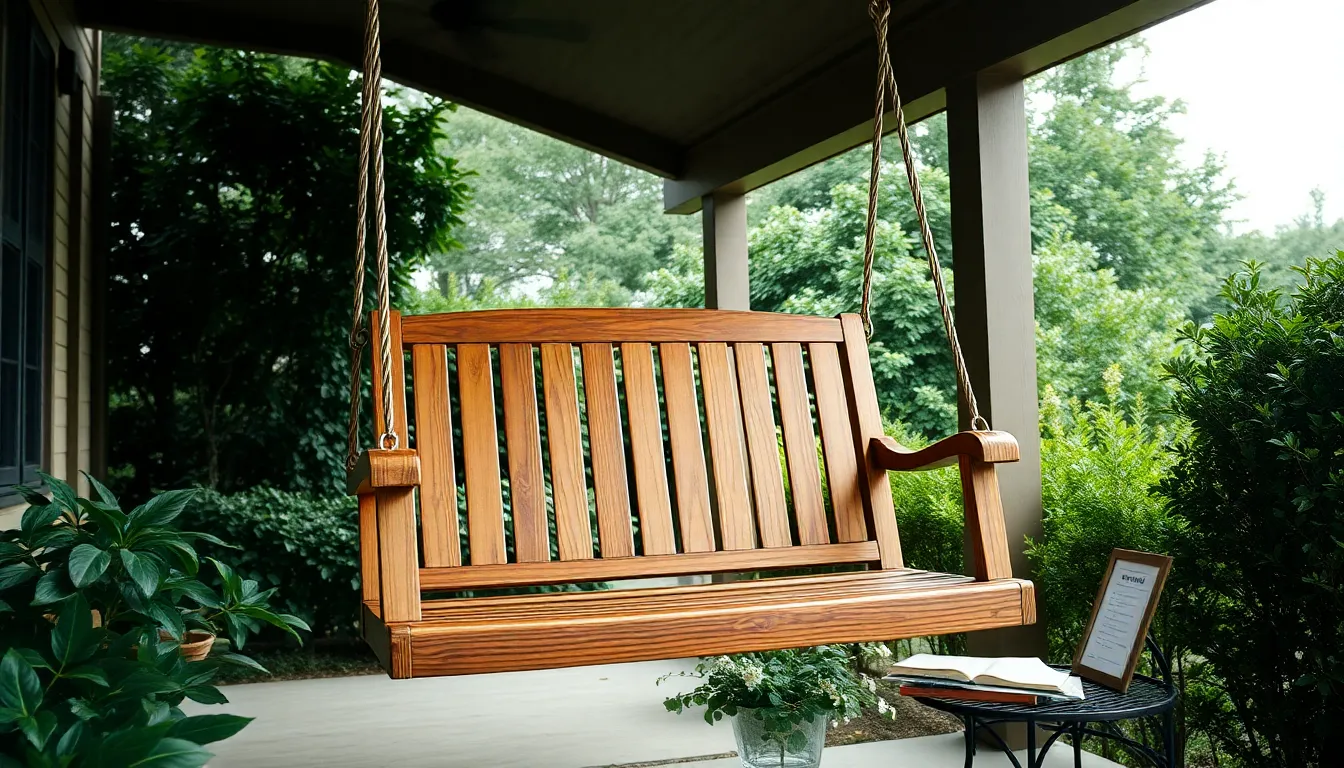
Proper maintenance ensures your porch swing installation remains safe and enjoyable for years to come. We’ll help you establish routines that protect your investment and keep your family secure.
Regular Inspection Schedule
Inspect your swing’s hardware, chains, or ropes every few months to ensure no rust, fraying, or wear compromises safety. We recommend checking all connection points including eye bolts, quick links, and S-hooks during each inspection. Look for any signs of metal fatigue or corrosion that could indicate weakening components.
Tighten any loose bolts or screws during inspections to maintain structural integrity. Check that ceiling hooks remain securely fastened to the joists and haven’t worked loose over time. Test the swing’s stability by gently applying pressure to different areas before each use.
Document your inspection findings in a maintenance log to track any recurring issues. We suggest taking photos of hardware conditions to monitor degradation patterns over time. Schedule professional inspections annually for swings that experience heavy use or harsh weather exposure.
Weather Protection and Seasonal Care
Protect swings from prolonged exposure to rain or snow by using covers or removing cushions during bad weather. We recommend storing fabric accessories indoors during winter months to prevent mold and deterioration. Consider installing retractable canopies or awnings to shield your swing from intense sunlight and precipitation.
Treat wooden swings with sealant annually to prevent rot and fading from UV exposure. Apply marine-grade wood preservatives before each season to maintain the swing’s appearance and structural integrity. Clean metal components with appropriate solvents to remove salt buildup and prevent accelerated corrosion.
Winterize your swing installation by removing or securing loose components that could be damaged by high winds. We suggest loosening chains slightly during freezing temperatures to allow for metal contraction. Cover exposed hardware with protective wraps to minimize ice formation and moisture penetration.
Hardware Replacement Guidelines
Replace metal hooks, chains, or rope if you notice rust, corrosion, or fraying to maintain safety standards. We recommend using marine-grade or galvanized hardware to resist weather damage and extend component lifespan. Never attempt repairs on compromised suspension elements; complete replacement ensures continued safety.
Upgrade to heavier duty hardware if your current installation shows signs of stress or inadequate load capacity. Match replacement components to or exceed the specifications of your original hardware for optimal performance. Keep spare hardware on hand including extra chains, rope, and mounting bolts for quick replacements.
Source replacement parts from reputable suppliers who can verify load ratings and material specifications. We advise consulting the swing manufacturer’s recommendations for compatible hardware types and sizes. Professional installation may be necessary for complex hardware upgrades or structural reinforcements.
Conclusion
We’ve covered everything you need to transform your porch into a relaxing retreat with the perfect swing installation. From choosing the right location and hardware to mastering different mounting techniques for various ceiling types you now have the knowledge to create a safe and beautiful outdoor sanctuary.
Remember that your porch swing investment will pay dividends for years when you prioritize proper installation and regular maintenance. Whether you’re installing on traditional wood joists or exploring creative alternatives like A-frame stands your attention to safety and detail will ensure countless hours of peaceful enjoyment.
Take your time with each step and don’t hesitate to consult professionals when needed. Your family will thank you for creating this perfect spot to unwind and connect with nature right from your own porch.
Frequently Asked Questions
What is the ideal height for hanging a porch swing?
The optimal height for a porch swing seat is between 17 to 19 inches above the ground. This range provides comfortable seating for most adults while ensuring safe entry and exit. Consider adjusting the height slightly lower for children or elderly family members who may need easier access to the swing.
How much weight should porch swing hardware support?
All mounting points should be capable of supporting at least 500 pounds to ensure safety. This accounts for the swing’s weight plus multiple occupants and dynamic forces from swinging motion. Use heavy-duty ceiling hooks, eye bolts, and ensure installation into load-bearing joists for maximum security.
What’s the difference between chains and ropes for hanging swings?
Chains offer superior durability and weather resistance but can be noisier and require more maintenance to prevent rust. Ropes provide quieter operation and aesthetic appeal but need regular replacement due to weather exposure and UV damage. Consider galvanized chains for longevity or marine-grade rope for natural appearance.
How do I hang a swing from different ceiling types?
For wood ceilings, use heavy-duty lag screws or eye bolts into joists. Concrete requires masonry anchors and appropriate drill bits. Metal ceilings need specialized hardware like beam clamps or toggle bolts. Always verify the ceiling material and use hardware rated for the specific material to ensure proper installation.
What are alternative hanging options if I don’t have a suitable porch?
Consider freestanding A-frame swing stands for versatile placement without permanent installation. Tree branches can support swings with proper hardware and safety assessment. Pergolas and gazebos also provide excellent mounting structures while enhancing your outdoor space’s aesthetic appeal and functionality.
How often should I inspect my porch swing installation?
Inspect your porch swing monthly during active use seasons, checking for rust, fraying, loose bolts, and wear patterns. Document findings in a maintenance log and address issues immediately. Professional inspections are recommended annually for heavily used swings or those exposed to harsh weather conditions.
What safety features should I include in my swing installation?
Install safety cables as backup support to prevent falls if primary suspension fails. Space hangers 2-4 inches wider than the swing’s length for proper weight distribution. Use swivel hardware to prevent chain twisting and ensure at least four mounting points to distribute weight evenly across the structure.
How do I protect my porch swing from weather damage?
Use weatherproof covers during storms and store cushions indoors when not in use. Apply appropriate treatments to wooden swings and clean metal components regularly to prevent rust. Choose marine-grade or galvanized hardware for superior weather resistance and replace compromised components promptly with manufacturer-compatible parts.

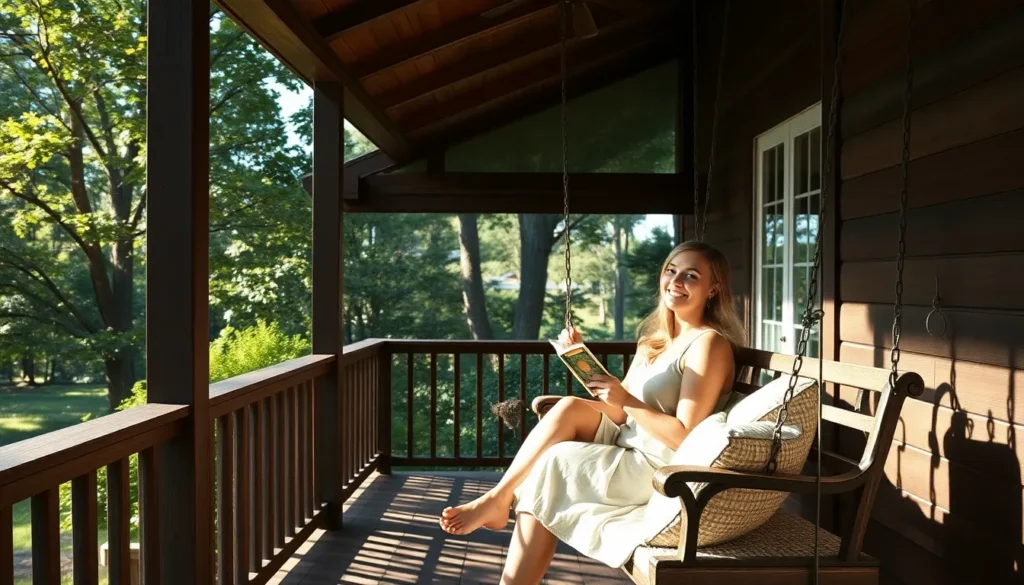



![X-CUIRASS [Premium] Swing Hanger, 8000 LBS Capacity, Heavy Duty 10MM](https://m.media-amazon.com/images/I/51HwVd2AiML._SL500_.jpg)








